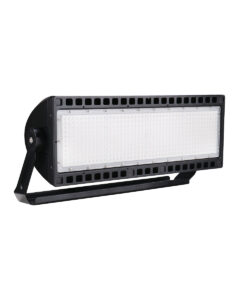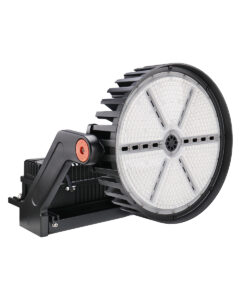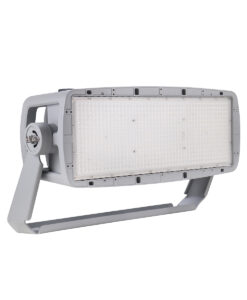Football field lighting standards are crucial for player safety, performance, and spectator enjoyment. At PacLights, we understand the importance of proper illumination in sports facilities.
This guide breaks down the key aspects of football field lighting, from illumination requirements to energy-efficient solutions. We’ll explore the latest technologies and best practices to help you create the optimal lighting setup for your football field.
How Bright Should a Football Field Be?
Illumination Standards for Different Levels of Play
Football field illumination significantly affects player performance, safety, and spectator experience. The required brightness varies based on the level of play and specific regulations.

High school football fields require different light levels depending on spectator capacity:
- Up to 2,000 spectators: 30 footcandles (minimum)
- Up to 5,000 spectators: 50 footcandles (minimum)
College-level play demands higher standards, typically between 100-150 footcandles.
Professional leagues, such as the NFL, have even stricter requirements. NFL lighting standards require an average of at least 200 footcandles for broadcast lighting. This ensures optimal visibility for both players and high-definition television broadcasts.
Achieving Uniform Illumination
Uniform lighting promotes player safety and fair play. The max/min ratio of footcandles should not exceed:
- 2.5 for high school fields
- 2.0 for college fields
This ratio prevents overwhelming brightness differences between the brightest and darkest areas of the field, maintaining consistent visibility across the entire playing surface.
To achieve this uniformity, careful consideration of pole placement and fixture selection is necessary. Football fields typically use 4, 6, or 8 pole configurations (depending on field size, desired light levels, and budget constraints).
Color Quality and Temperature
Color rendering and temperature play significant roles in football field lighting quality. For optimal visibility and accurate color reproduction (especially for televised games), lights should have a Color Rendering Index (CRI) of 70 or above. This ensures that colors appear vivid and true-to-life, which is essential for distinguishing between teams and seeing the ball clearly.
The color temperature of the lights also impacts overall atmosphere and visibility. Most stadium lights should have a color temperature between 5000-6000K. This range provides a crisp, white light that closely mimics natural daylight, enhancing visibility and reducing eye strain for players and spectators alike.
LED Technology in Football Field Lighting
LED technology has become increasingly popular for football field lighting due to its energy efficiency, longevity, and superior light quality. LED lights offer several advantages:
- Energy Efficiency: LED lights consume less power than traditional lighting solutions, reducing operational costs.
- Longevity: With a lifespan often exceeding 50,000 hours, LED lights require less frequent replacement.
- Instant On/Off: Unlike some traditional lighting options, LED lights reach full brightness immediately.
- Dimming Capabilities: Many LED systems offer dimming options, allowing for flexible light levels based on specific needs.
When selecting lighting solutions for football fields, it’s important to consider these factors to create an optimal playing environment. The next section will explore different types of football field lighting systems in more detail, including a comparison between metal halide and LED solutions.
Choosing the Right Football Field Lighting System
LED vs Metal Halide: A Clear Comparison
The selection of an appropriate lighting system for football fields impacts performance, energy efficiency, and long-term costs. In the past, metal halide lights were common for football field illumination. However, LED technology has transformed sports lighting, offering significant advantages over traditional options.

LED lights surpass metal halide in several key areas:
- Energy Efficiency: LED lights use about 75% less electricity than metal halide fixtures, which leads to substantial cost savings over time.
- Lifespan: Metal halide bulbs typically last around 10,000 hours, while LED lights can function for 50,000 hours or more (reducing replacement frequency and maintenance costs).
- Light Quality: LEDs provide superior color rendering and maintain consistent light output over time. Metal halide lights can experience color shift and diminished brightness as they age.
- Instant On/Off: LED lights reach full brightness immediately, unlike metal halide fixtures which require a warm-up period.
- Directional Lighting: LEDs offer better control over light distribution, which reduces light pollution and improves overall field illumination.
These advantages make LED lighting the top choice for modern football field installations.
Optimizing Pole Placement and Fixture Mounting
The effectiveness of a lighting system depends heavily on proper pole placement and fixture mounting. Key considerations include:
- Number of Poles: Most football fields use either 4, 6, or 8 pole configurations. The choice depends on field size, desired light levels, and budget constraints.
- Pole Height: Taller poles (typically 70-80 feet for football fields) provide better light distribution and reduce glare. However, they may cost more to install and maintain.
- Fixture Mounting: Crossarm mounts allow precise aiming of multiple fixtures, while direct pole-top mounts can cost less for smaller installations.
- Light Trespass: Proper pole placement and fixture aiming help minimize light spill into surrounding areas, which reduces light pollution and potential complaints from neighbors.
A lighting design professional can help optimize pole and fixture layout for maximum effectiveness and efficiency.
Advanced Control Systems
Modern football field lighting systems benefit from advanced control capabilities. These features enhance functionality and contribute to energy savings and improved user experience:
- Dimming: Adjustable light levels allow energy savings during practices or non-game events.
- Zoning: The ability to illuminate specific areas of the field independently provides flexibility for various activities.
- Scheduling: Automated on/off times can prevent unnecessary energy use and extend system lifespan.
- Remote Control: Smartphone apps or web-based interfaces allow easy management of lighting systems from anywhere.
- Integration: Some systems integrate with other stadium operations (such as scoreboards or emergency systems) for streamlined management.
When selecting a control system, consider future needs and potential for expansion. A scalable system can adapt to changing requirements over time.
The next chapter will explore energy efficiency and sustainability in football field lighting, building on the foundation of LED technology and advanced control systems discussed here.
How Football Fields Can Maximize Energy Efficiency
The LED Revolution in Football Field Lighting
LED lighting has become the gold standard for football field illumination. These fixtures can result in up to 70% energy savings compared to traditional lighting systems. A typical football field that switches from traditional to LED lighting can save thousands of dollars annually on energy bills.

The energy efficiency of LED lights extends beyond power consumption. LEDs don’t require a warm-up period, which allows for instant on/off capabilities. This feature enables more precise control over when and how the lights are used, which further reduces unnecessary energy consumption.
Harnessing Renewable Energy for Football Fields
Many football facilities now integrate renewable energy sources with their lighting systems. Solar panels installed on stadium roofs or nearby structures can offset a significant portion of the energy used by the lighting system. Some facilities report generating up to 20% of their total energy needs through on-site solar installations.
Wind turbines present another option for stadiums located in areas with consistent wind patterns. While the initial investment may be higher, the long-term energy savings and reduced carbon footprint make renewable energy integration a worthwhile consideration for many football facilities.
Smart Controls for Optimized Energy Use
Advanced lighting control systems play a key role in maximizing energy efficiency. These systems allow for precise scheduling, dimming capabilities, and even weather-based adjustments. A smart control system can automatically reduce light output on overcast days or during practices when full illumination isn’t necessary.
Some football fields report energy savings of up to 50% by implementing smart controls alongside their LED lighting systems. These controls not only save energy but also extend the lifespan of the lighting fixtures by reducing unnecessary usage.
Maintenance Strategies for Long-Term Efficiency
LED lights require less maintenance than traditional lighting systems, but proper upkeep remains essential for maintaining energy efficiency over time. Regular cleaning of fixtures, checking for loose connections, and prompt replacement of any malfunctioning components can prevent energy waste and ensure optimal performance.
Annual maintenance checks for football field lighting systems prove beneficial. During these checks, technicians can assess the system’s efficiency, make necessary adjustments, and identify any potential issues before they lead to increased energy consumption or reduced light quality.
The implementation of these energy-efficient strategies allows football fields to significantly reduce their environmental impact and operating costs while maintaining high-quality illumination for players and spectators alike. The initial investment in LED technology (such as those offered by PacLights), renewable energy integration, and smart controls often pays for itself within a few years through reduced energy bills and maintenance costs.
Football field lighting standards have evolved significantly due to technological advancements and increased focus on player safety and performance. Proper illumination creates a safe and enjoyable environment for players, officials, and spectators. The shift to LED lighting has revolutionized the industry, offering superior energy efficiency, longevity, and light quality compared to traditional systems.

Color rendering and temperature play a vital role in creating an optimal visual environment. Modern lighting systems closely mimic natural daylight, allowing for accurate color perception and reduced eye strain. The future of football field lighting will likely see continued advancements in LED technology, more sophisticated smart control systems, and increased integration with renewable energy sources.
At PacLights, we offer cutting-edge lighting solutions that meet and exceed football field lighting standards. Our energy-efficient LED fixtures and advanced control options provide football facilities with the tools they need to create exceptional playing environments. We strive to minimize operational costs and environmental impact while ensuring the future of football remains bright.





Disclaimer: PacLights is not responsible for any actions taken based on the suggestions and information provided in this article, and readers should consult local building and electrical codes for proper guidance.